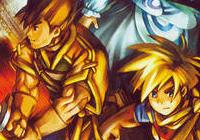Golden Sun (Game Boy Advance) Review
By Adam Riley  03.02.2003
03.02.2003

Camelot, previously most famous for its sturdy work on the Mega Drive ‘Force’ series, suddenly shot back into the limelight when Nintendo handed them Mario & company for two new sports titles. Mario Golf and Mario Tennis were hailed as brilliant on the N64, and the GameBoy Colour versions (which had strong RPG-roots sewn in) were deemed to be some of the best games on the system. The GameBoy Advance eventually came along, and lo-and-behold Camelot tagged along for the ride, announcing a game that would blow the launch titles out of the water – thus Golden Sun was born.
Features:
This is an epic quest, full of the usual RPG clichés regarding good and evil. The game is set in a world shared by two immense continents, Angara and Gondowan. Alchemy rules over the land and there are individuals (Adepts) that can telekinetically move items or attack using a special power, Psynergy. You start out with a scene inside a little village – your main character, Isaac, and his friend Garet bear witness to their home being engulfed by a rockslide. Then the game skips three years ahead to show the main evils of the game, Menardi and Saturos, and reveals their plot to infiltrate Sol Sanctum, the place where four Elemental Stones are held, and ultimately use the new power to wreak havoc on the world. Of course this is the cue for Isaac, Garet and two other Adepts (Mia and Ivan) you come across, to step in and save humanity!

The fact that such spectacular graphics could be churned out on what many people thought was little more than a portable SNES, certainly bemused many a naysayer at the time of release. Many have actually likened Golden Sun to a PSX game, and they certainly have a strong case. Compared to games like Capcom’s Breath of Fire III and even the classic Squaresoft RPG Xenogears, Camelot’s offering can definitely hold its own. Cute little characters, highly-detailed backgrounds and environments, and, of course, the wondrous magical effects and summons – from time to time you will most likely rub your eyes just to make sure they’re not playing games with you…this title’s graphics really are as good as they look, no tricks!
Whilst there is no voice-sampling of any kind in the game, the ample amount of aurally-pleasing in-game music more than makes up for it. Games so far for the handheld have not exactly pushed the boat out in the sound department, but thankfully here Camelot prove that what the Super Nintendo did, the GameBoy Advance can now do much better. Orchestration of tunes – mellow pan pipes and strings being present throughout the game – means that it is definitely recommended that you wear your headphones in order to fully appreciate the effort that has been poured into the tiny cartridge. In fact, better yet, do what I do and plug your speaker system into the GBA! It is well worth it.

The first main gripe that is encountered is when you are an hour into the game, yet the proper action still hasn’t started. You see, the developers have tried to produce such an elaborate plot that the introduction needed for all of the characters and the unveiling of the story takes far too long for those who are eager to just dive straight into the action. But you should be patient as, even though clichéd, the story is captivating. What the developers shouldn’t have included, though, is some of the conversation interactivity. Having the option to answer ‘Yes’ or ‘No’ in important places is fine, but when you’re asked something like ‘Those enemies sure are evil aren’t they?’ and you’re given the choice of answering ‘Yes’ or ‘No’ it just gets stupid and ultimately annoying.
But once you’re in, you’re in until the end. The simpler puzzles will have you wracking your brain trying to figure out where to push that final statue or tile piece. The tougher puzzles, though, require you to use the different Psynergy powers that your characters have – for example: ‘Move’ will help you drag items that can’t be pushed; ‘Reveal’ highlights hidden features in your surroundings; and ‘Whirlwind’ allows you to open-up secret entrances that were previously covered by vines and leaves. These Psynergies are gained by the collection of creatures called ‘Djinn’ – which if attached to different characters via the simple menu system, allow access to different abilities. It is through these useful creatures that you can utilise the game’s breath-taking summons during battle. Simply use the Djinni power a certain amount of times, and eventually you will have enough energy to use your summons, resulting in on-screen devastation as they pound your enemy into dust. So to sum-up: a wide range of puzzles, the excellent creature collection option, multiple random battles and an easy-to-use menu system all make for a game that can stand proud amongst the Dragon Quests and Final Fantasies of the world.

Up to 40 hours can be sucked from your life if you play through collecting all the Djinn and Levelling-Up sufficiently, which for a handheld title is more than enough. There are 28 Djinn to find, some of which are in awkward, seemingly impossible-to-reach places. But everything is possible - you just need to make sure you’ve used the correct Psynergy to open up the right route. Bosses are arduous, but with patience when building up your levels, your work will be duly rewarded. Puzzles can be taxing, and very frustrating at times, but eventually something clicks, and *Bingo!* you’ve done it! And finally there are the options of being able to battle in an arena on your own or use your Djinn against those of a friend, which is basically two-player Pokémon, which is no bad thing in terms of adding to the longevity of the game.

Cubed3 Rating
Exceptional - Gold Award

Very, very impressive. But those that have played Camelot’s previous games should have expected no less since the company has a lot of experience behind it. This is an absorbing RPG that, although at times frustrating, will keep you hooked right until the final credits roll. With Golden Sun: The Lost Age due for later this year, the time is definitely ripe to pick this up.

![]() 9/10
9/10
![]() 10/10
(17 Votes)
10/10
(17 Votes)
 Out now
Out now  Out now
Out now  Out now
Out now  Out now
Out now Comments
Comments are currently disabled

 Sign In
Sign In Game Details
Game Details Subscribe to this topic
Subscribe to this topic Features
Features






 Top
Top

